What Is the Bond Joining Lipid Monomers Together Called?

Lipids do not form polymers, so they lack a specific bond joining lipid monomers together. Fatty acids connect to glycerol via an ester bond.
Understanding Lipid Structure
Unlike proteins, nucleic acids, or carbohydrates, lipids do not assemble into long polymer chains. Instead, lipids exist as individual molecules or small complexes.
For example, triglycerides consist of one glycerol molecule bonded to three fatty acids. Phospholipids have two fatty acids linked to glycerol with an added phosphate group.
Type of Bond: Ester Linkage
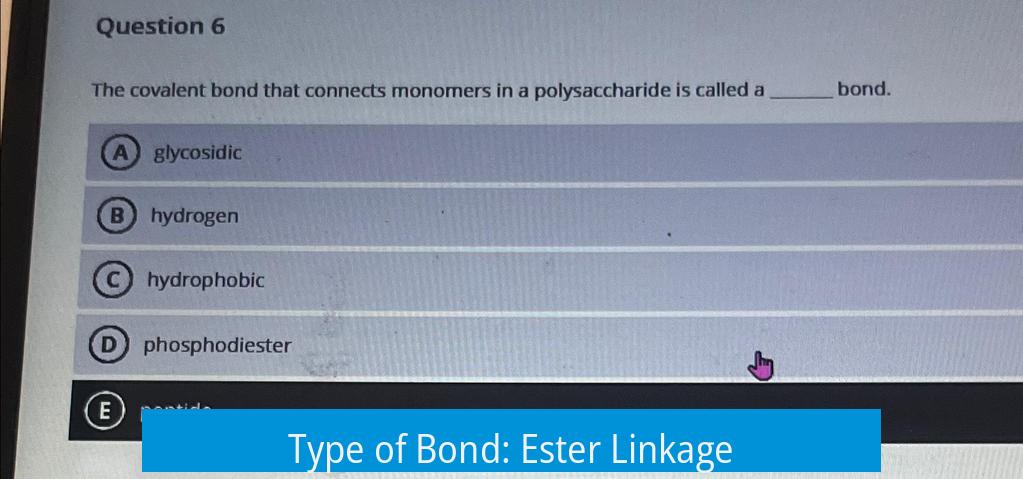
The bond connecting fatty acid molecules to glycerol is an ester bond. This bond forms through a condensation reaction between the hydroxyl (-OH) groups of glycerol and the carboxyl (-COOH) groups of fatty acids.
| Component | Bond Type | Chemical Group |
|---|---|---|
| Fatty Acid to Glycerol | Ester bond | COO-R |
This ester bond is common in biochemistry and not unique to lipids. It is classified by the resulting functional group rather than a special lipid-specific bond.
Lipid Assembly Beyond Covalent Bonds
Lipids assemble into larger structures like membranes not by covalent polymerization, but by self-assembly. Hydrophobic interactions among fatty acid tails drive the organization into bilayers or monolayers.
These arrangements rely on physical forces rather than chemical bonds linking monomers. Thus, the cohesion of lipid structures is due to non-covalent forces, not bonded chains.
Common Misconceptions
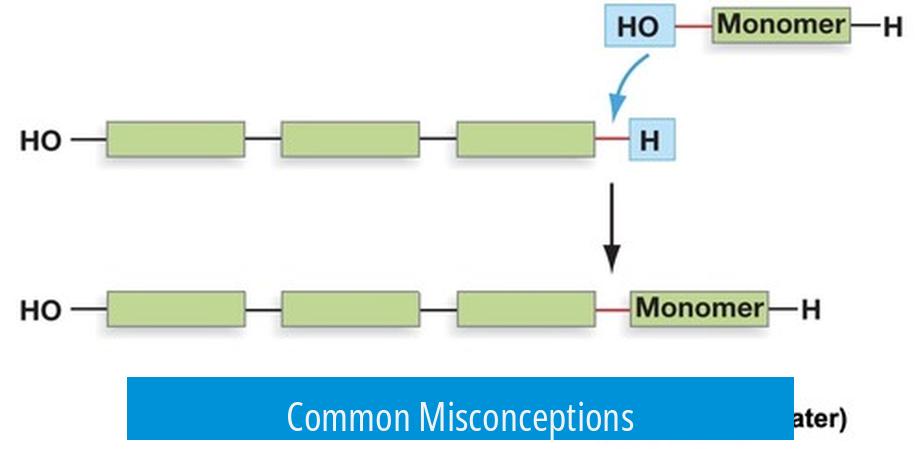
- Lipids do not form polymers, so there is no ‘lipid bond’ joining monomers like peptide or glycosidic bonds.
- The ester bond connects glycerol and fatty acids but does not form chains of lipids.
- Lipid membranes arise from hydrophobic packing, not covalent linkages.
Key Takeaways
- Lipids are not polymers and do not have a specific connecting bond between monomers.
- Fatty acids link to glycerol via ester bonds (COO-R functional group).
- Ester bonds form by condensation of hydroxyl and carboxyl groups.
- Lipid structures form via hydrophobic interactions and self-assembly.
- No unique “lipid bond” exists as with other macromolecular polymers.
What is the bond joining lipid monomers together called?
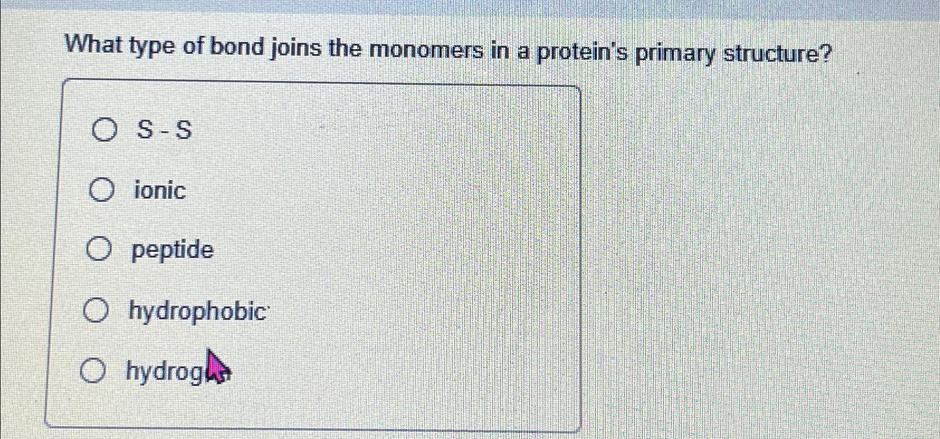
Let’s dive right in and clear the fog on this common confusion in biochemistry. Lipids do not have a specific bond joining monomers together because, quite simply, they don’t form polymers. This might ruffle some feathers if you assumed lipids chain up like proteins or carbohydrates. Instead, what happens in lipids like triglycerides is a bit different.
So, what exactly *holds* a triglyceride together? Picture a glycerol molecule playing host to three fatty acid chains. These fatty acids hook onto the glycerol backbone through what’s known as ester bonds. An ester bond forms when a hydroxyl group (–OH) from glycerol reacts with a carboxyl group (–COOH) from a fatty acid, creating a linkage often symbolized as COO-R. For phospholipids, the situation is similar but with just two fatty acids attached.
Why No Polymer Bond in Lipids?
Unlike proteins, which boast peptide bonds linking amino acids into lengthy chains, or carbohydrates, where glycosidic bonds string sugars together, lipids don’t play that game. Their monomers—the fatty acids and glycerol—aren’t constantly linking into repeating long chains. Instead, they form distinct molecules, such as triglycerides or phospholipids.
Imagine trying to build a Lego tower but only snapping together three pieces, rather than stringing hundreds. That’s lipid chemistry for you: small clusters, no repeating chain, no polymer.
So, Ester Bond: The Silent Connector
The ester bond in lipids isn’t a flashy, unique lipid-only bond. It appears in chemistry outside biology and doesn’t qualify as a ‘lipid bond’ per se. If you search for “the bond joining lipid monomers,” the answer is probably “ester bond,” but that’s a functional group name, not a specialized bonding term like “peptide” in proteins.
Do you think of ester bonds as “lipid’s little handshake”? That’s a pretty good image because it’s the essential connection making triglycerides and phospholipids possible. However, these bonds only link parts within a lipid molecule, not lipid molecules to each other in long chains.
What About Membranes? Not Covalent Bonds Here
A lot of times, people wonder, “If lipids don’t form polymers, how do they lock together to form membranes?” The secret is self-assembly. Lipids arrange themselves into bilayers or monolayers driven by non-covalent forces. The fatty acid tails—hydrophobic and water-avoiding—pack tightly through hydrophobic interactions, a sort of molecular crowding rather than true bonding.
“It’s like lipids throw a party where only similar guests cozy up, no strings attached!”
This self-assembly creates the dynamic structure of membranes without any covalent bonds tethering one lipid to another. That’s why membranes are fluid and flexible, essential qualities for cells.
Let’s Debunk a Misconception About Lipid Bonds
Sometimes, people mistakenly think the bond joining lipid units is a fancy “lipid bond.” Jokes aside, the talk about “lipid bonds” is a bit of a myth. The key connections are just simple C–C bonds within fatty acid chains—typical carbon-carbon bonds you find in most hydrocarbons—and the ester bonds linking fatty acids to glycerol.
There’s no specialized ‘lipid polymer bond.’ If you’re dealing with triglycerides, focus on ester bonds. If you’re addressing how lipids stick in membranes, think hydrophobic interactions, not chemical bonds.
Why Does This Matter?
Understanding that lipids don’t form polymers immediately clarifies why their biochemical behavior differs. For example, enzymes called lipases target those ester bonds to release fatty acids quickly. Unlike proteins or DNA, where breaking chain bonds can disrupt the entire molecule, breaking one ester bond in a triglyceride just detaches one fatty acid—making lipid digestion fast and efficient.
This knowledge impacts nutrition, pharmacology, and materials science—knowing where to break or make bonds is vital for designing drugs, understanding metabolism, or crafting bio-compatible materials.
Summary Table: Lipid Bond Basics
| Feature | Explanation | Example |
|---|---|---|
| Polymer Formation | Do lipids form long chains (polymers)? | No |
| Bond Linking Fatty Acids to Glycerol | Type of chemical bond | Ester Bond (COO-R) |
| Bond Between Lipids in Membranes | Type of interaction holding lipids together | Hydrophobic interactions (non-covalent) |
| Lipid Polymer Bond Name | Specific name? | None (does not exist) |
Final Thoughts
If you ask a biochemist “What is the bond joining lipid monomers together called?” they might smile and say, “Trick question!” Because lipids aren’t polymers, they don’t have a unique polymer linkage bond. Instead, their fatty acids hook onto glycerol by ester bonds. The grand assembly of lipids into structures like membranes is powered by hydrophobic interactions, not by chains of covalent bonds.
So, next time you look at a lipid molecule, remember: no polymer strings, just a trio of fatty acids joined by trusty esters, packing tightly in a hydrophobic dance that builds life’s membrane boundaries.
What type of bond links fatty acids to glycerol in lipids?
Fatty acids are linked to glycerol by ester bonds (COO-R). These bonds form when a fatty acid reacts with glycerol, creating triacylglycerols or phospholipids.
Do lipids form polymers like proteins or carbohydrates?
No, lipids do not form polymers. They exist mostly as individual molecules linked by ester bonds, not repeating monomer chains.
Is there a unique bond name for joining lipid monomers?
There is no special bond name for joining lipid monomers because lipids do not polymerize. The common link, ester bond, is a functional group found in other molecules too.
How do lipids form membranes without polymer bonds?
Lipids self-assemble into membranes through hydrophobic interactions. These are non-covalent forces, not covalent bonds, that organize lipids into layers.
Are ester bonds specific only to lipids?
No, ester bonds form in many biological molecules. In lipids, they connect fatty acids to glycerol, but the bond itself is not unique to lipids.


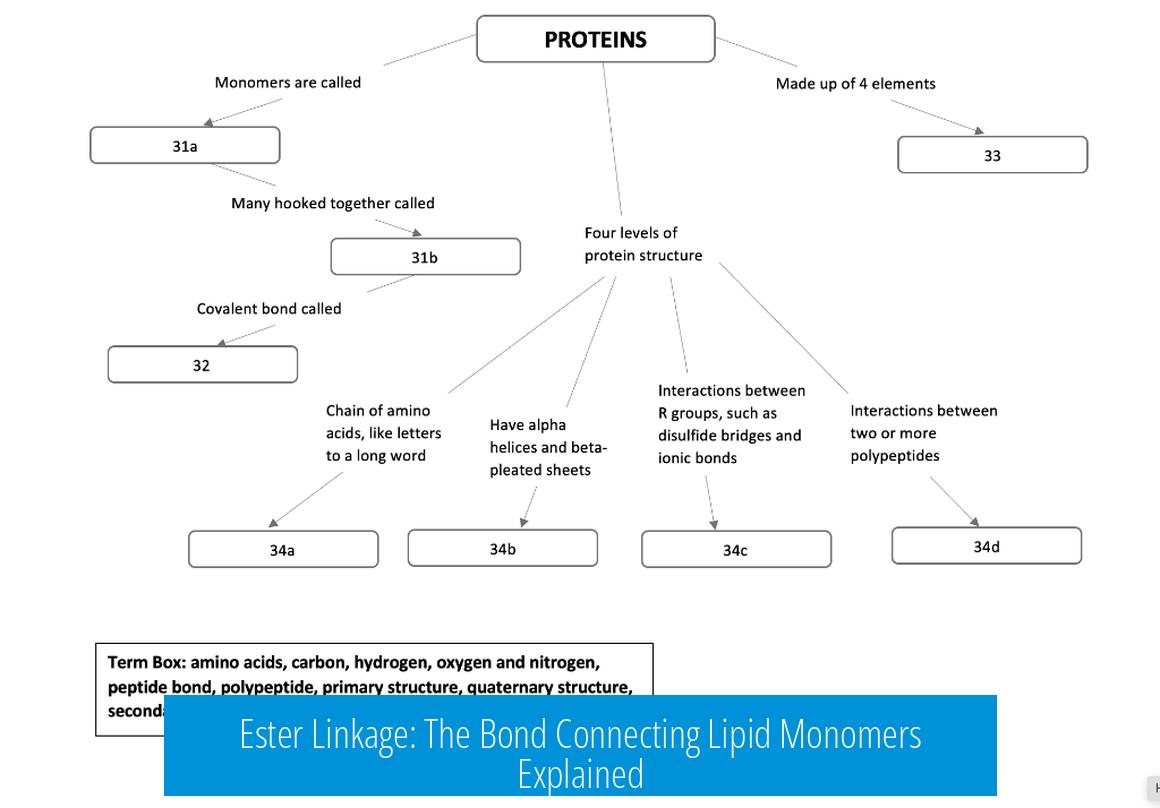

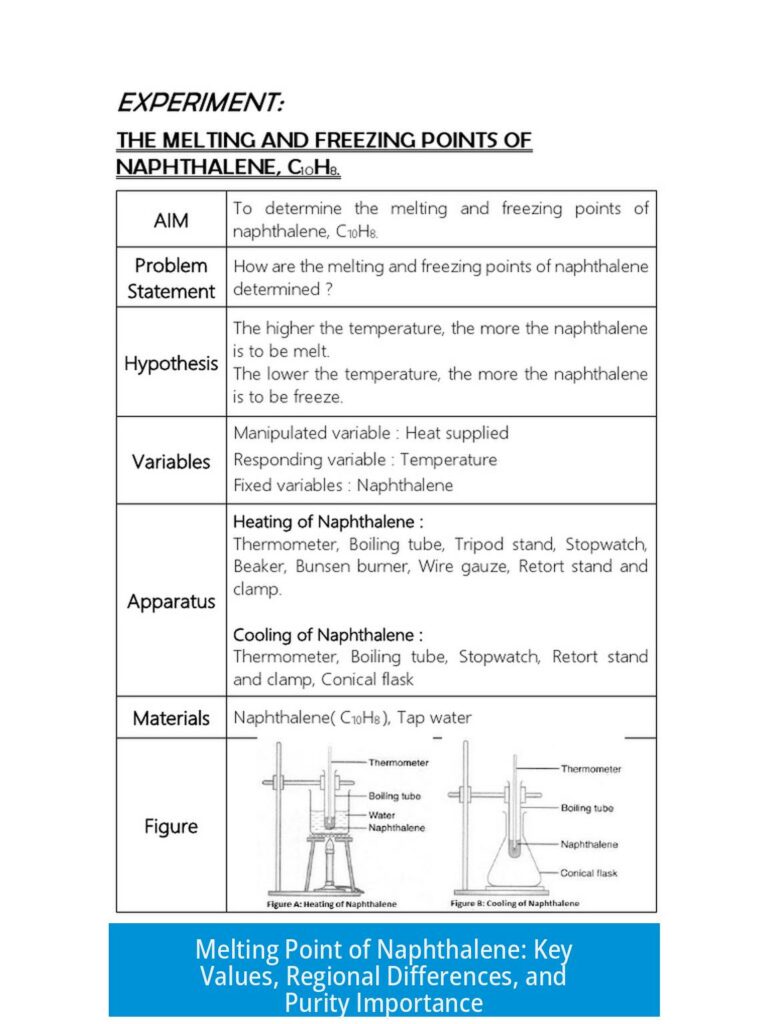
Leave a Comment